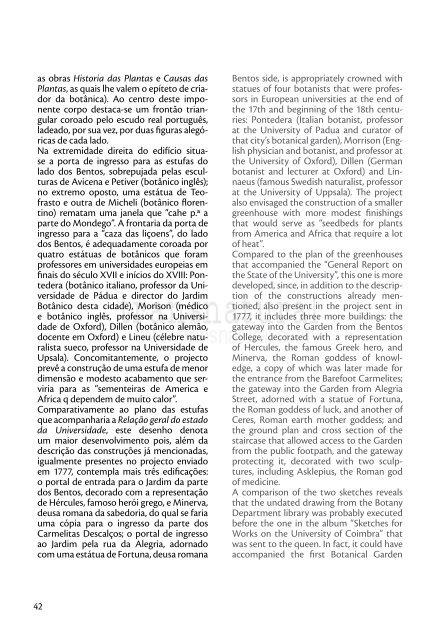Jardim Botânico de Coimbra: contraponto entre a Arte e a ... - artez
Jardim Botânico de Coimbra: contraponto entre a Arte e a ... - artez
Jardim Botânico de Coimbra: contraponto entre a Arte e a ... - artez
Create successful ePaper yourself
Turn your PDF publications into a flip-book with our unique Google optimized e-Paper software.
as obras Historia das Plantas e Causas das<br />
Plantas, as quais lhe valem o epíteto <strong>de</strong> criador<br />
da botânica). Ao centro <strong>de</strong>ste imponente<br />
corpo <strong>de</strong>staca-se um frontão triangular<br />
coroado pelo escudo real português,<br />
la<strong>de</strong>ado, por sua vez, por duas figuras alegóricas<br />
<strong>de</strong> cada lado.<br />
Na extremida<strong>de</strong> direita do edifício situase<br />
a porta <strong>de</strong> ingresso para as estufas do<br />
lado dos Bentos, sobrepujada pelas esculturas<br />
<strong>de</strong> Avicena e Petiver (botânico inglês);<br />
no extremo oposto, uma estátua <strong>de</strong> Teofrasto<br />
e outra <strong>de</strong> Micheli (botânico florentino)<br />
rematam uma janela que “cahe p.ª a<br />
parte do Mon<strong>de</strong>go”. A frontaria da porta <strong>de</strong><br />
ingresso para a “caza das liçoens”, do lado<br />
dos Bentos, é a<strong>de</strong>quadamente coroada por<br />
quatro estátuas <strong>de</strong> botânicos que foram<br />
professores em universida<strong>de</strong>s europeias em<br />
finais do século XVII e inícios do XVIII: Ponte<strong>de</strong>ra<br />
(botânico italiano, professor da Universida<strong>de</strong><br />
<strong>de</strong> Pádua e director do <strong>Jardim</strong><br />
<strong>Botânico</strong> <strong>de</strong>sta cida<strong>de</strong>), Morison (médico<br />
e botânico inglês, professor na Universida<strong>de</strong><br />
<strong>de</strong> Oxford), Dillen (botânico alemão,<br />
docente em Oxford) e Lineu (célebre naturalista<br />
sueco, professor na Universida<strong>de</strong> <strong>de</strong><br />
Upsala). Concomitantemente, o projecto<br />
prevê a construção <strong>de</strong> uma estufa <strong>de</strong> menor<br />
dimensão e mo<strong>de</strong>sto acabamento que serviria<br />
para as “sementeiras <strong>de</strong> America e<br />
Africa q <strong>de</strong>pen<strong>de</strong>m <strong>de</strong> muito calor”.<br />
Comparativamente ao plano das estufas<br />
que acompanharia a Relação geral do estado<br />
da Universida<strong>de</strong>, este <strong>de</strong>senho <strong>de</strong>nota<br />
um maior <strong>de</strong>senvolvimento pois, além da<br />
<strong>de</strong>scrição das construções já mencionadas,<br />
igualmente presentes no projecto enviado<br />
em 1777, contempla mais três edificações:<br />
o portal <strong>de</strong> entrada para o <strong>Jardim</strong> da parte<br />
dos Bentos, <strong>de</strong>corado com a representação<br />
<strong>de</strong> Hércules, famoso herói grego, e Minerva,<br />
<strong>de</strong>usa romana da sabedoria, do qual se faria<br />
uma cópia para o ingresso da parte dos<br />
Carmelitas Descalços; o portal <strong>de</strong> ingresso<br />
ao <strong>Jardim</strong> pela rua da Alegria, adornado<br />
com uma estátua <strong>de</strong> Fortuna, <strong>de</strong>usa romana<br />
42<br />
Bentos si<strong>de</strong>, is appropriately crowned with<br />
statues of four botanists that were professors<br />
in European universities at the end of<br />
the 17th and beginning of the 18th centuries:<br />
Ponte<strong>de</strong>ra (Italian botanist, professor<br />
at the University of Padua and curator of<br />
that city’s botanical gar<strong>de</strong>n), Morrison (English<br />
physician and botanist, and professor at<br />
the University of Oxford), Dillen (German<br />
botanist and lecturer at Oxford) and Linnaeus<br />
(famous Swedish naturalist, professor<br />
at the University of Uppsala). The project<br />
also envisaged the construction of a smaller<br />
greenhouse with more mo<strong>de</strong>st finishings<br />
that would serve as “seedbeds for plants<br />
from America and Africa that require a lot<br />
of heat”.<br />
Compared to the plan of the greenhouses<br />
that accompanied the “General Report on<br />
the State of the University”, this one is more<br />
<strong>de</strong>veloped, since, in addition to the <strong>de</strong>scription<br />
of the constructions already mentioned,<br />
also present in the project sent in<br />
1777, it inclu<strong>de</strong>s three more buildings: the<br />
gateway into the Gar<strong>de</strong>n from the Bentos<br />
College, <strong>de</strong>corated with a representation<br />
of Hercules, the famous Greek hero, and<br />
Minerva, the Roman god<strong>de</strong>ss of knowledge,<br />
a copy of which was later ma<strong>de</strong> for<br />
the entrance from the Barefoot Carmelites;<br />
the gateway into the Gar<strong>de</strong>n from Alegria<br />
Street, adorned with a statue of Fortuna,<br />
the Roman god<strong>de</strong>ss of luck, and another of<br />
Ceres, Roman earth mother god<strong>de</strong>ss; and<br />
the ground plan and cross section of the<br />
staircase that allowed access to the Gar<strong>de</strong>n<br />
from the public footpath, and the gateway<br />
protecting it, <strong>de</strong>corated with two sculptures,<br />
including Asklepius, the Roman god<br />
of medicine.<br />
A comparison of the two sketches reveals<br />
that the undated drawing from the Botany<br />
Department library was probably executed<br />
before the one in the album “Sketches for<br />
Works on the University of <strong>Coimbra</strong>” that<br />
was sent to the queen. In fact, it could have<br />
accompanied the first Botanical Gar<strong>de</strong>n


